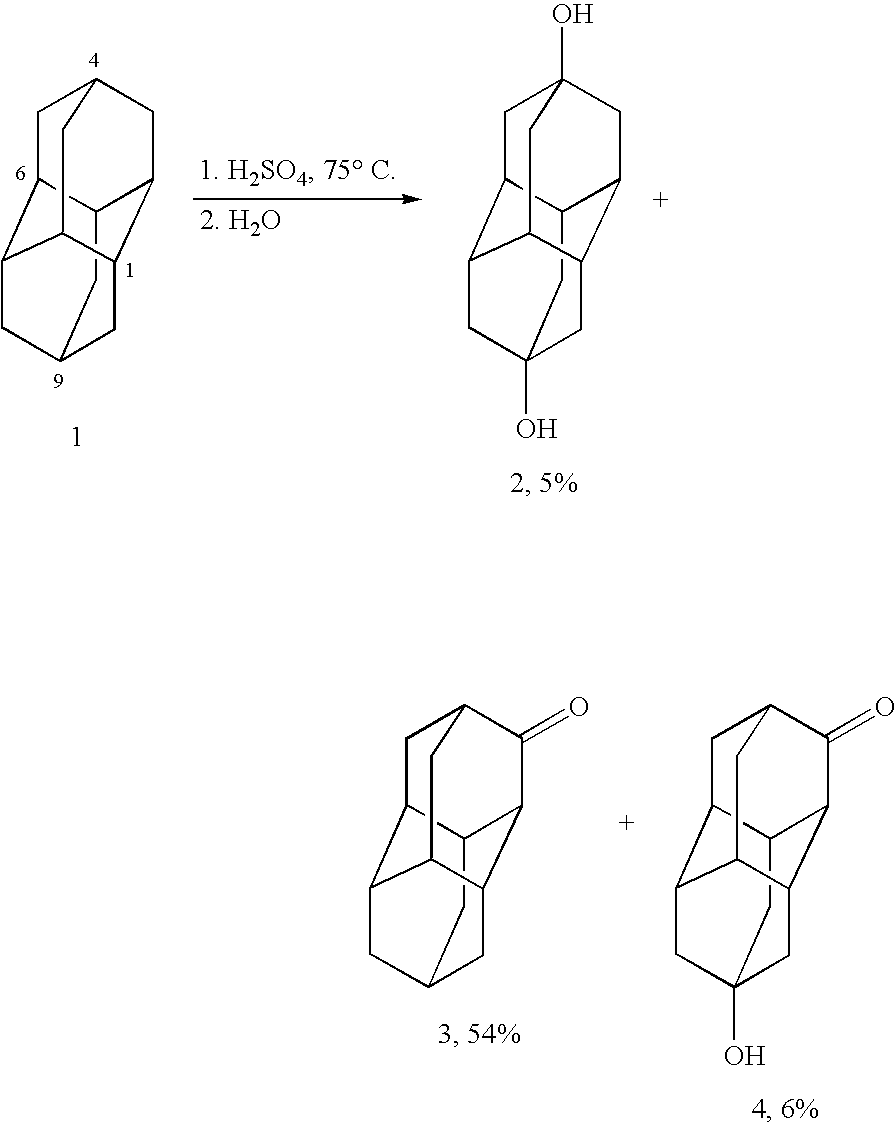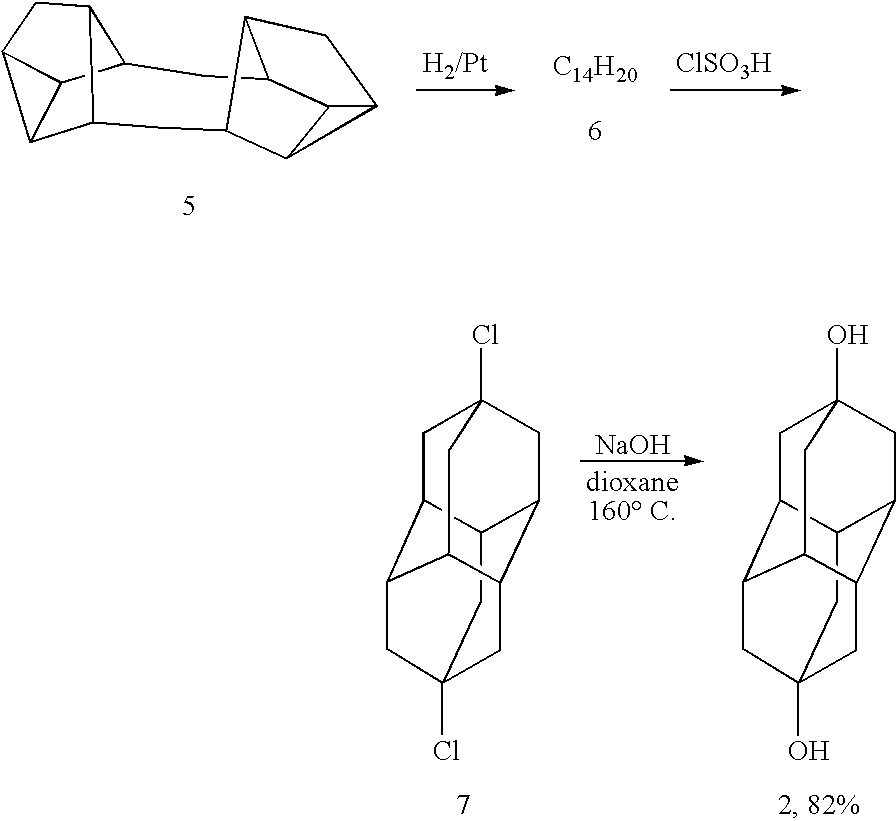Method for producing substituted diamantanes
a technology of substituted diamantanes and diamonds, which is applied in the preparation of carboxylic compounds, organic chemistry, chemistry apparatus and processes, etc., can solve the problems of low yield of hydroxylated diamantanes, complex purification steps, and/or use of fine chemicals, and achieve high yield and/or selectivity.
- Summary
- Abstract
- Description
- Claims
- Application Information
AI Technical Summary
Benefits of technology
Problems solved by technology
Method used
Image
Examples
embodiment 1
Production of 1-nitroxydiamantane
[0069]
[0070]Diamantane 1 (19.3 g; 0.103 mol), CH2Cl2 (100 mL) and 99% HNO3 (38.5 mL; 0.91 mol) are mixed at 0° C., stirred for 30 minutes at 20° C., cooled to 0° C. and the excess acid is neutralised with solid NaHCO3. The precipitate is filtrated and CH2Cl2 removed at reduced pressure. The remaining remainder after removal of CH2Cl2 is recrystallised from n-hexane and yields 21.7 g (85%) 1-nitroxydiamantane 22.
[0071]1H-NMR: (400 MHz, δ, ppm, CDCl3): 2.30 bs (2H), 2.15 bs (3H), 2.05 m (6H), 1.68 m (4H), 1.60 m (2H), 1.47 m (2H).
[0072]13C-NMR: (100 MHz, δ, ppm, CDCl3): 93.7 (C), 40.5 (CH), 39.3 (CH2), 39.2 (CH), 37.5 (CH2), 36.7 (CH2), 36.3 (CH), 32.3 (CH2), 30.3 (CH), 24.6 (CH).
[0073]Characteristic bands in the IR spectrum: (ν, cm−1, CHCl3): 2997 (C—H), 2855 (C—H), 1611 (N═O), 1306 (N═O), 1247 (C—O).
embodiment 2
Production of 1-acetaminodiamantane
[0074]
[0075]1 g (4.0 mmol) 1-nitroxy diamantane 22 is dissolved in 100 mL acetonitrile. The reaction mixture is heated to reflux for 10 h and subsequently cooled to room temperature. Then 1 mL water is added. After removal of the volatile components at reduced pressure, the remainder of CCl4 is recrystallised. 0.78 g (79%) of 1-acetaminodiamantane 23 yield.
[0076]1H-NMR: (400 MHz, δ, ppm, CDCl3): 5.50 (brs, 1H), 2.22 (m, 2H), 2.03 (m, 2H), 1.93 (m, 4H), 1.90 (s, 4H), 1.49 (m, 2H), 1.45 (m, 8H).
[0077]13C-NMR: (100 MHz, δ, ppm, CDCl3): 169.1, 56.1, 41.5, 39.1, 38.7, 38.1, 37.3, 37.0, 32.8, 28.6, 25.1, 24.5. MS (70 eV) (m / z, %): 245 (71), 230 (14), 202 (7), 186 (94), 171 (4), 157 (6), 143 (11), 130 (45), 129 (41), 95 (90), 94 (100), 79 (25), 67 (18), 53 (11).
embodiment 3
Production of 1-diamantane Carboxylic Acid
[0078]
[0079]1 g (4.0 mmol) 1-nitroxy diamantane 22 is added at a temperature of 10° C. under stirring to a mixture of 25 mL of 98% H2SO4 and 2 mL formic acid. Additionally, at this temperature during 1 h a further 3 mL formic acid are added. The reaction mixture is poured onto 100 g ice and extracted three times with 20 mL chloroform, respectively. The combined extracts are first washed with water, subsequently with brine and dried over Na2SO4. Removal of the solvent at reduced pressure and subsequent recrystallisation of the remainder of CHCl3 yield 0.75 g (81%) 1-diamantane carboxylic acid 24.
PUM
| Property | Measurement | Unit |
|---|---|---|
| pKa | aaaaa | aaaaa |
| temperature | aaaaa | aaaaa |
| temperature | aaaaa | aaaaa |
Abstract
Description
Claims
Application Information
 Login to View More
Login to View More - R&D
- Intellectual Property
- Life Sciences
- Materials
- Tech Scout
- Unparalleled Data Quality
- Higher Quality Content
- 60% Fewer Hallucinations
Browse by: Latest US Patents, China's latest patents, Technical Efficacy Thesaurus, Application Domain, Technology Topic, Popular Technical Reports.
© 2025 PatSnap. All rights reserved.Legal|Privacy policy|Modern Slavery Act Transparency Statement|Sitemap|About US| Contact US: help@patsnap.com



